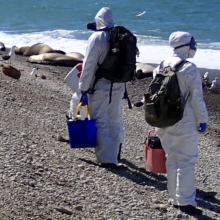A pivotal history of Earth lies submerged beneath the Bering Sea.
Today this frigid strait separates North America and Asia, but geologists suspect when the oceans were dramatically lower a land bridge tied the two continents together — allowing humans and other species to cross into the Americas. Scientists thought the Bering Land Bridge mirrored the dry grassy plains found in the nearby Siberian steppe ecosystem. But new research, employing a vessel's sonar and coring technology, shows the environment was likely dominated by bogs, floodplains, and snaking streams.
The soggy bridge might have allowed some to pass, but not others.
"The watery, wet landscape could have been a barrier for some species, or a pathway for species that actually travel by water," Jenna Hill, a U.S. Geological Survey geologist who coauthored the research, said in a statement. "That’s how this fits into the bigger picture."
The research, entitled "The Bering Land Bridge During the Last Glacial Stage: Great Grazing or Buggy Bogs?" will be presented at the American Geophysical Union's 2024 meeting.
Before Earth's glaciers dramatically receded and filled the oceans at the end of the last ice age some 11,000 years ago, the bridge was an expansive migration corridor, spreading 1,000 miles from north to south. Humans began crossing over by around 16,500 years ago, which many scientists argue was the earliest (but not the only) migration to the Americas.
Agile, though at times drenched, humans could have skirted ponds and bogs as they slogged westward towards modern-day Alaska. But some larger ice mammals — who never made it across — might have been deterred by the wet region. For example, woolly rhinos never made it to North America, while American camels (who went extinct some 12,000 years ago) and short-faced bears (who inhabited great swathes of North America including Alaska and the Yukon) never made it to Asia.
Even though the bridge was open for business, conditions there may have thwarted much movement. Pleistocene bison made two big migrations into North America. "But DNA analysis shows a fair amount of genetic separation of Pleistocene bison from east and west Beringia suggesting there was only limited movement of bison back west over the land bridge," Pamela Groves, a research scientist at the University of Alaska Fairbanks, previously wrote.
Yet some iconic ice age herbivores still found ways to cross.
"It may have been marshy, but we are still seeing evidence of mammoths," Sarah Fowell, a paleogeologist at the University of Alaska Fairbanks, said in a statement. "Even if it was mostly floodplains and ponds, the grazers were around, just uphill following higher, drier areas."


The Bering Land Bridge's boggy environs were revealed by a research cruise aboard the R/V Sikuliaq, an over 260-foot oceanographic vessel operated by the University of Alaska Fairbanks. The researchers used sonar (which bounces signals off the seafloor) to identify low-lying regions of the former land bridge, and then captured sediment cores from 36 different submerged sites, hundreds of feet underwater.
They found sediments from freshwater lakes, abundant egg cases from freshwater fleas, moss leaves, and beyond. The evidence clearly showed a swampy world.
"We were looking for several large lakes," explained Fowell. "What we actually found was evidence of lots of small lakes and river channels."
The new, hard-earned findings will almost certainly stoke more scientific study and debate about this influential Arctic region, and how it helped mold the diverse world we see today.
Topics Animals











